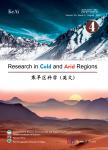Cluster planting impact on cotton growth, yield and biomass accumulation in an arid region oasis
Cluster planting impact on cotton growth, yield and biomass accumulation in an arid region oasis作者机构:College of Forestry Gansu Agricultural University Linze Inland River Basin Research Station/Key Laboratory of Ecohydrology of Inland River Basin Northwest Institute of Eco-Environment and Resources Chinese Academy of Sciences Linze Inland River Basin Research Station/Key Laboratory of Land Surface Process and Climate Change in Cold and Arid Regions Northwest Institute of Eco-Environment and Resources Chinese Academy of Sciences
出 版 物:《Research in Cold and Arid Regions》 (寒旱区科学(英文版))
年 卷 期:2018年第10卷第3期
页 面:271-278页
核心收录:
基 金:supported by the National Natural Sciences Foundation of China(31300323) China Postdoctoral Science Foundation Funded Project(2014M552515)
主 题:cluster planting growth parameter biomass crop growth rate distribution ratio
摘 要:The cluster planting pattern (3 plants per hole) for cotton (Gossypium hirsutum L.) may increase economic yield over those of the traditional planting pattern (1 plant per hole) in arid regions of China. This increase in yield depends on either increased biomass production or greater partitioning to fruit. This study was conducted to determine whether differences in biomass accumulation or partitioning to reproductive growth contributed to higher yield in the cluster planting pattern compared with the traditional one. Growth parameters, biomass accumulation, crop growth rate and partitioning between cluster planting pattern and traditional planting pattern was compared in northwest of China. The biomass production and partitioning in cluster planting plot was higher than in traditional planting one. Biomass accumulation was faster early in the clustered treatment, and it was also higher at harvest time. Total dry matter production per unit area was significantly higher than in the traditional planting. On a per plant basis, dry matter accumulation was faster and total biomass production was significantly higher in the cluster planting pattern. Numbers of sympodia and boll sizes were also larger, indicating that facilitation among plants was promoting crop yield. The increase in yield in the cluster planting treatment occurred through increased partitioning of dry matter to fruits than in the traditional planting pattern, resulting in more bolls and increased lint yield in arid regions.



